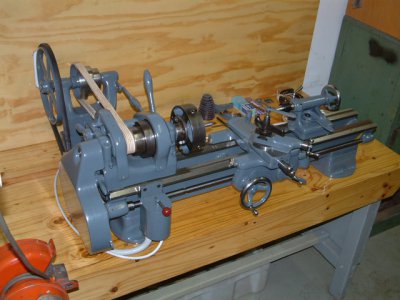Dear Rex,
Forget the lapping of ways. Diesel engine injector nozzles get lapped to their respective bodies. Not lathe way surfaces. Daryl is right. If you want to do anything to a lathe bed ways, the only way is by hand scraping and for that you will need a number of years practice (and tons of patience) to get right. If I were you, I'd approach the whole lathe rebuild in a way that you end up with a machine that is in a better condition than before you took it to bits.
For your lathe, inspect the ways and remove any burrs that you may observe on any of the slides. By burrs, I mean little knocks or dings that the casting edges or surfaces may have received. This you can carefully remove with a file in the localised area of the dimple that is higher than the average height of the slide surface. Then obtain some engineers marking blue and put a thin layer on one of the mating slide parts, normally the longer slide. Then with no oil, put the mating slide onto the way and give it a full length slide over the way, remove the casting and have a look at the un-blued slide. you will see that some of the blue would have transferred to the slide that was not blued. A normal contact pattern is around 60 to 70 %. You will also be able to see if there are any high spots or if the average bearing surface is good or not. A lot of what I'm saying has to do with developing a feel for things, which you will come to appreciate with time.
If everything looks good, clean the slides and put them together with a thin film of oil and slide the castings together and feel if they bind or slide over the full length that they are intended to work on. For this test you will have to put the jib's back into the slide and adjust them to ensure that you can slide them without any noticeable rocking, binding or seizure. For all intents and purposes, if the slides do not bind and feel good, they are good and you should not need to do anything else, to have a lathe that will give you years of good service.
For what you describe as backlash, this I presume is with the cross and compound slide threads and nuts. These are normally acme threads. If the acme threads have worn to any degree, they will look like normal threads with sharp points and these you will have to renew to reduce the backlash. If they are not severely worn, screw the respective nut onto the thread and feel if there are is any noticeable end play. End play may be noticeable in one part of the thread while at other parts of the thread it feels good. This is because the slide that the thread and nut assembly drives was used in this position the most and therefore has the most wear.
But don't despair, my Southbend 9 inch model C lathe cross slide has about 20 thou backlash and it works just fine. I just keep it in mind and snug up the slides if doing anything that may end up causing some chatter. I still turn to one thou accuracy, which is acceptable to me.
Re-assemble your lathe and I'm sure that you will have a better machine than what you started with. If anything, it will be cleaner and you may even want to paint her to make her look better. How about posting some photos of your lathe rebuild project. We all like the before and after pictures. Here is an after picture of my SB9C. Enjoy, Geoffrey.



